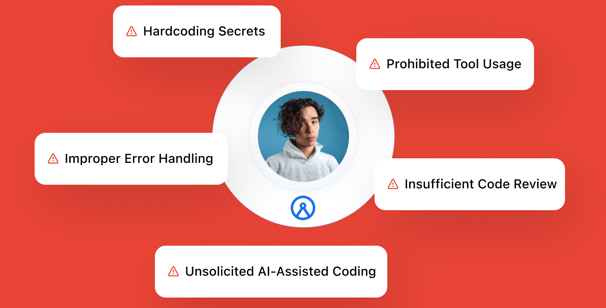Developer Detection Response (DevDR) builds upon traditional detection and response systems, targeting risks originating from developer activities. This forward-thinking approach actively monitors developer actions, evaluates behaviors, and automates responses to address security and compliance issues. DevDR shifts organizational focus from passive observation to proactive threat management and mitigation.
Key components of DevDR include:
Automated Monitoring and Detection: Tracks developer actions across tools and environments to identify risks such as bypassed reviews, unauthorized AI tool use, or insecure code submissions.
Risk Contextualization: Associates identified risks with specific developers to enable targeted responses and encourage responsibility.
Real-Time Alerts and Automated Actions: Issues immediate notifications for high-risk behaviors and enforces policies by blocking non-compliant code or isolating vulnerabilities.
Feedback Loops for Continuous Improvement: Provides developers with actionable insights to support skill development and promote secure coding practices.
Unified Data Collection and Analysis
DevDR aggregates data from various sources, including IDEs, CI/CD pipelines, and version control systems. By linking developer activities—such as using unapproved tools or skipping security scans—to broader risks, DevDR offers a comprehensive perspective on vulnerabilities tied to individual actions.
Incident Detection and Scoring
Using advanced analytics and machine learning, DevDR consolidates related developer activities into contextual incidents, assigning severity scores based on potential impact. This prioritization helps security teams focus on the most pressing threats.
Automated and Developer-Focused Responses
DevDR streamlines remediation by flagging insecure pull requests or enforcing security policies at the commit level. These targeted actions minimize the risk of vulnerabilities making it to production.
Core Advantages of DevDR:
Proactive Threat Detection: Identifies and flags risky developer behaviors in real time to reduce vulnerability exposure.
Streamlined Risk Management: Centralizes developer-related risks, simplifying workflows for security teams.
Compliance Assurance: Ensures adherence to security policies and regulations through automated enforcement.
Improved Developer Accountability: Links risks to individuals and delivers actionable feedback to encourage secure practices.
Prominent incidents emphasize the importance of Developer Detection Response (DevDR) in addressing risks caused by developer actions and inadequate posture management:
Insider Threats and Identity Mismanagement, Uber Breach (2022): A hacker leveraged compromised developer credentials to infiltrate critical systems, highlighting the need for proactive activity monitoring to prevent insider threats.
AI Code Vulnerabilities, GitHub Copilot Security Flaw (2024): Research revealed that AI tools like GitHub Copilot can produce insecure code snippets when working with flawed codebases, underscoring the importance of governing AI-assisted development and identifying insecure patterns in real time.
These examples illustrate the necessity of DevDR in swiftly addressing vulnerabilities introduced by developer actions.
The Archipelo SDLC Developer Security and Compliance Platform adopts a developer-first approach to securing the Software Development Lifecycle (SDLC), offering risk detection and actionable insights through the following capabilities:
DevSIEM & DevDR Track Events & Generate Actionable Insights: Proactively monitor and mitigate software security risks caused by developers throughout the SDLC.
Automated Developer & CI/CD Tool Governance: Scan developer and CI/CD tools to verify tool inventory and mitigate shadow IT risks with developers.
AI Code Usage & Risk Monitor: Monitor AI code tool usage to ensure
secure and responsible software development and innovation.
Developer Security Posture: Monitor security risks of developer
actions providing insights on their behavior and security posture.
By delivering these solutions, Archipelo helps organizations protect their SDLC, mitigate insider threats, and enhance software security.
Unlike conventional developer monitoring, which often targets productivity or static risk detection, DevDR leverages real-time analysis and automated responses. This approach ensures that vulnerabilities introduced by developers are identified and mitigated before they escalate, transforming the SDLC into a secure and efficient process.
Archipelo’s commitment to Developer Detection Response redefines software security, addressing risks at the code level with precision and speed. With DevDR, Archipelo empowers teams to create secure, compliant, and resilient software while supporting developers in adopting secure practices.
Contact us to learn how Archipelo can help secure your SDLC while aligning with DevSecOps principles.


